
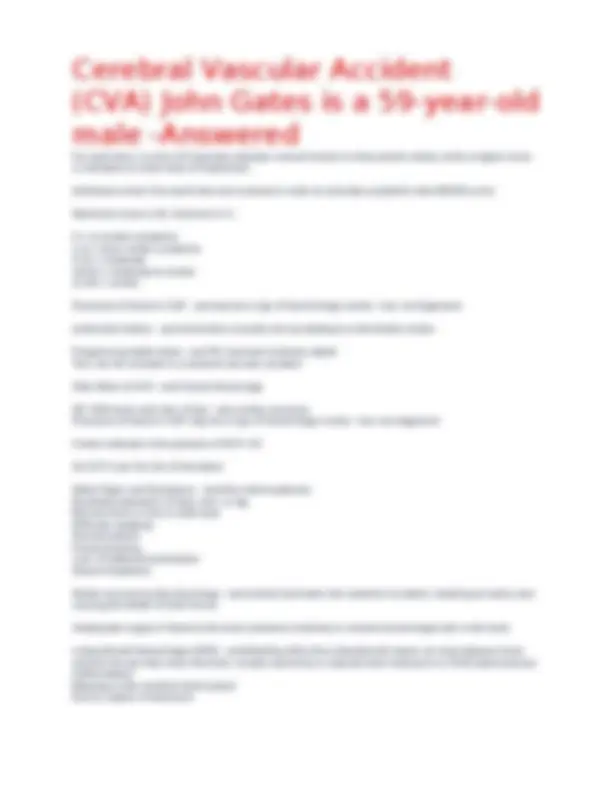
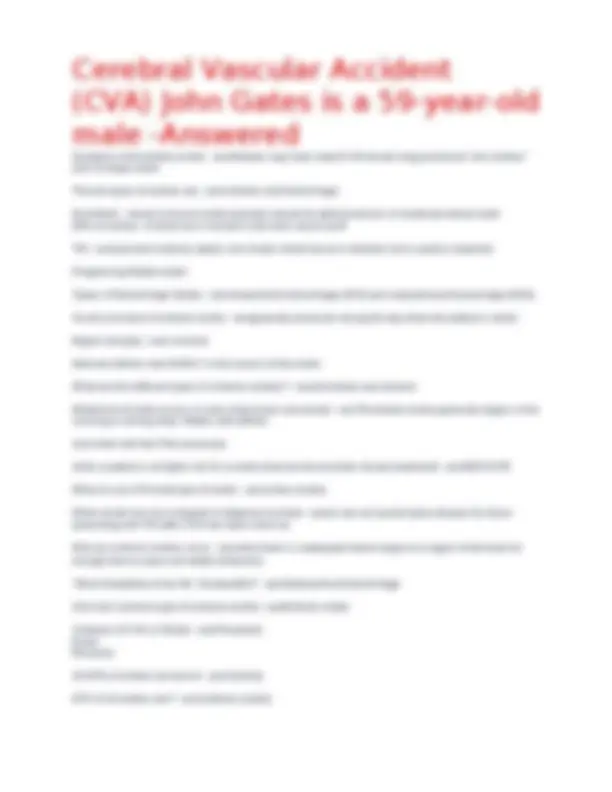
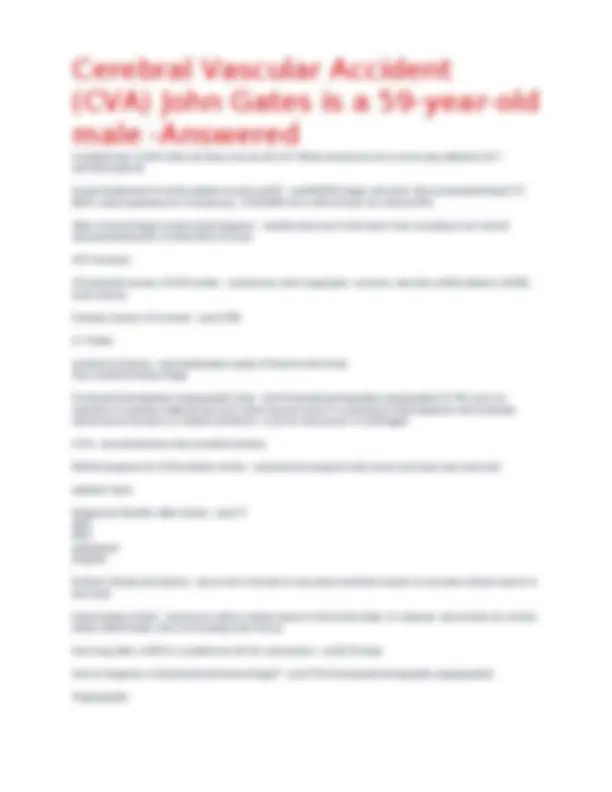
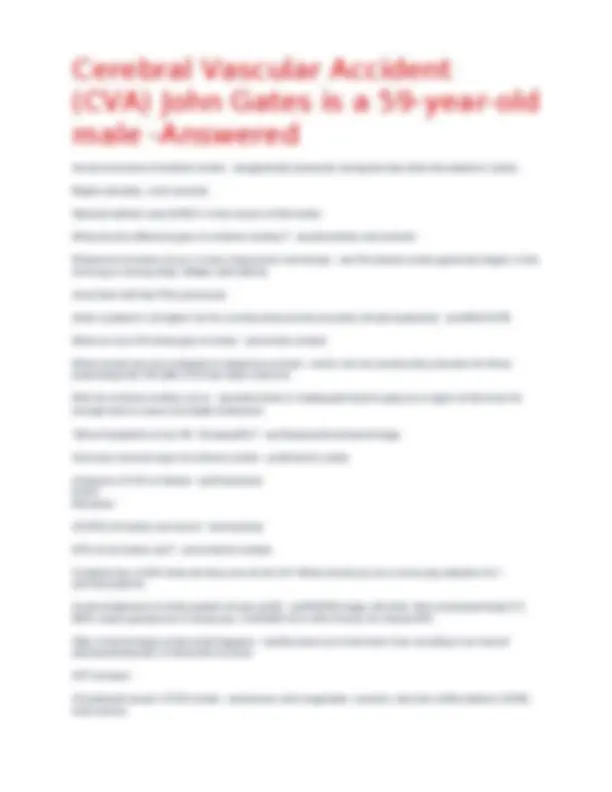
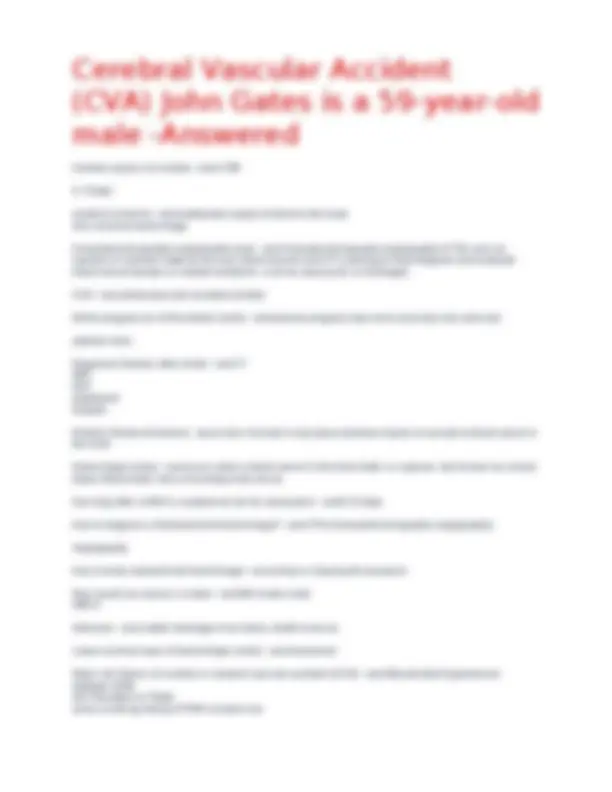
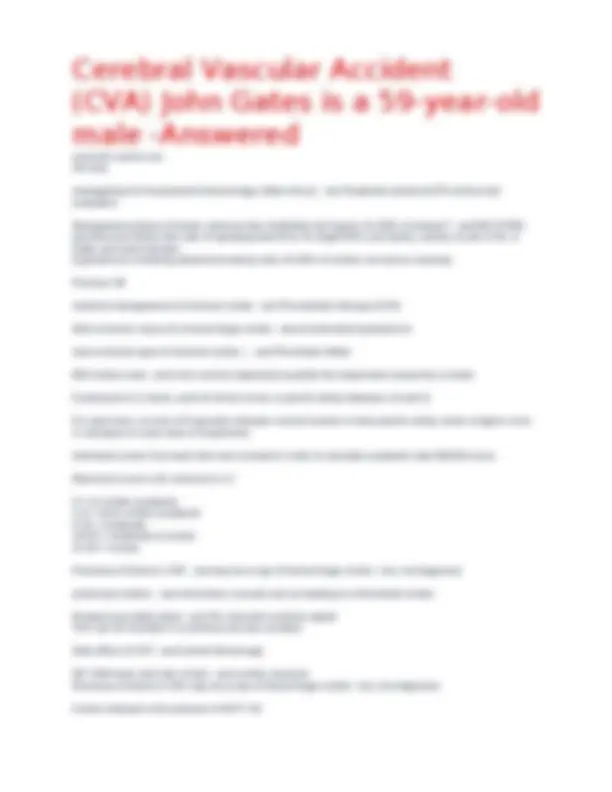
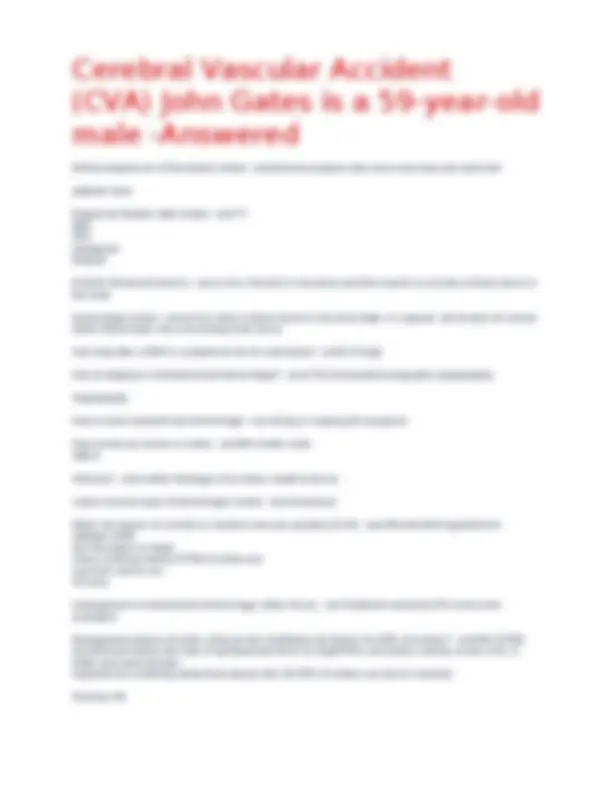
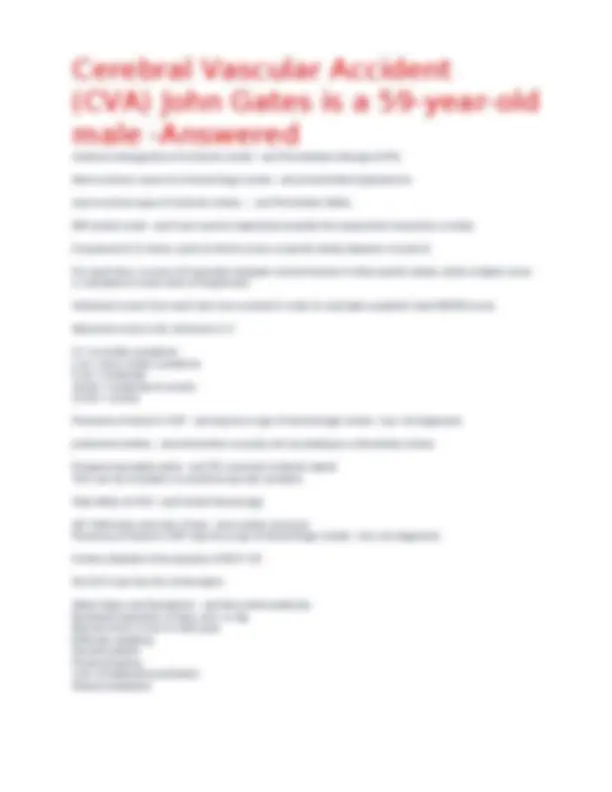
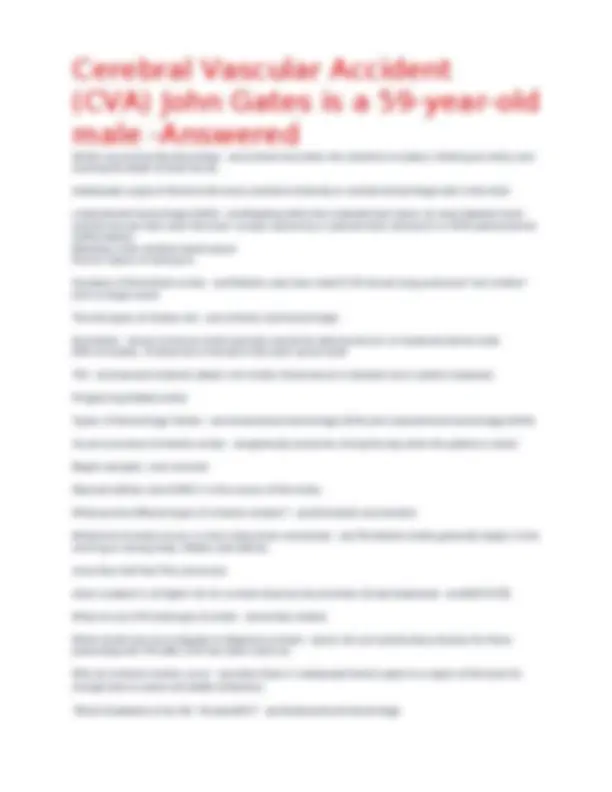
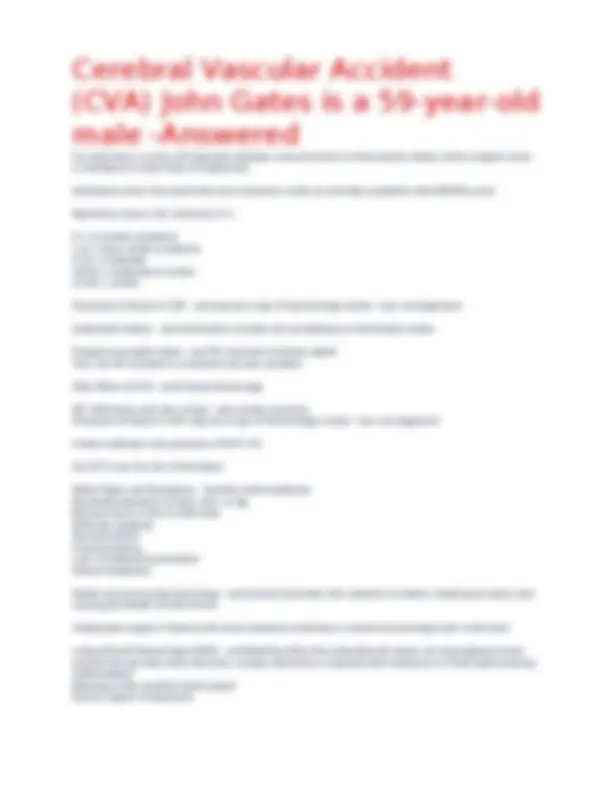
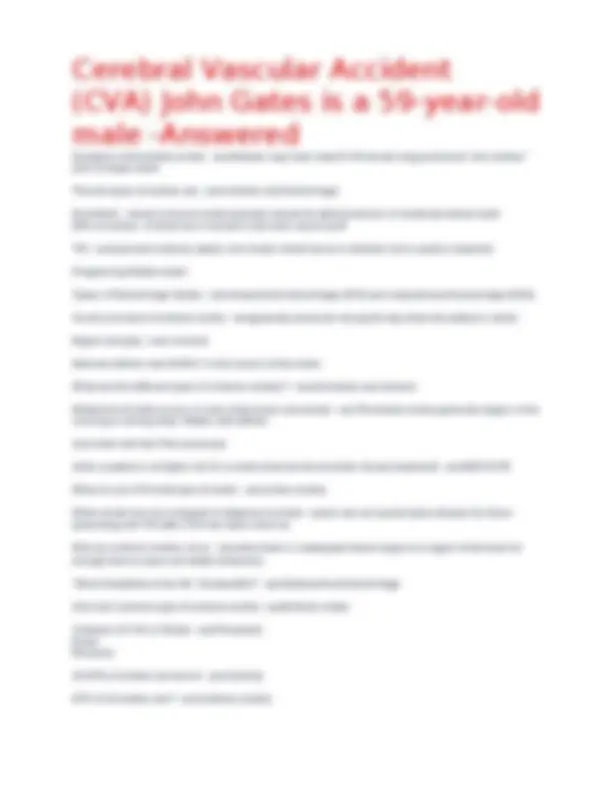
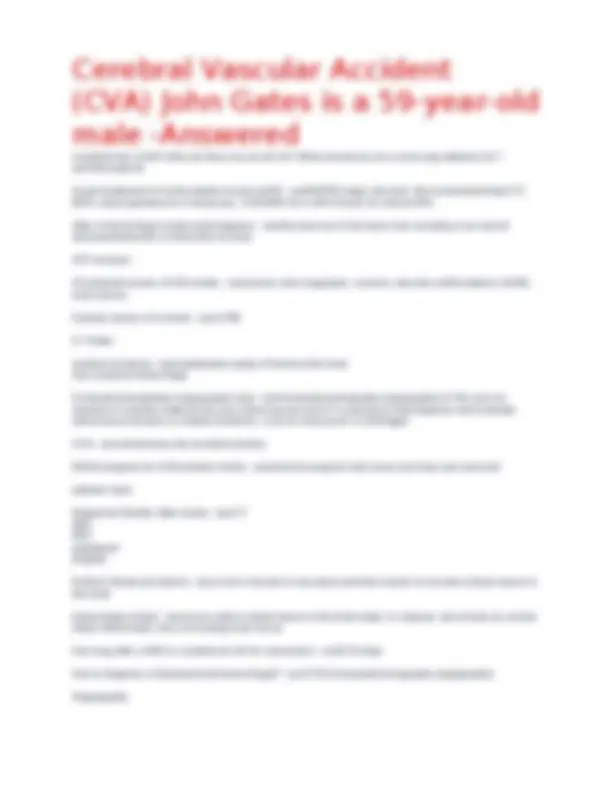
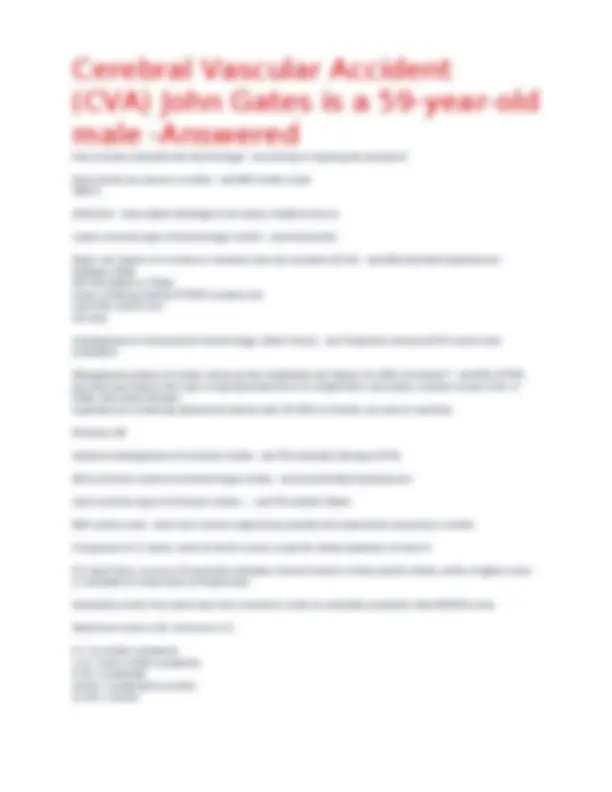
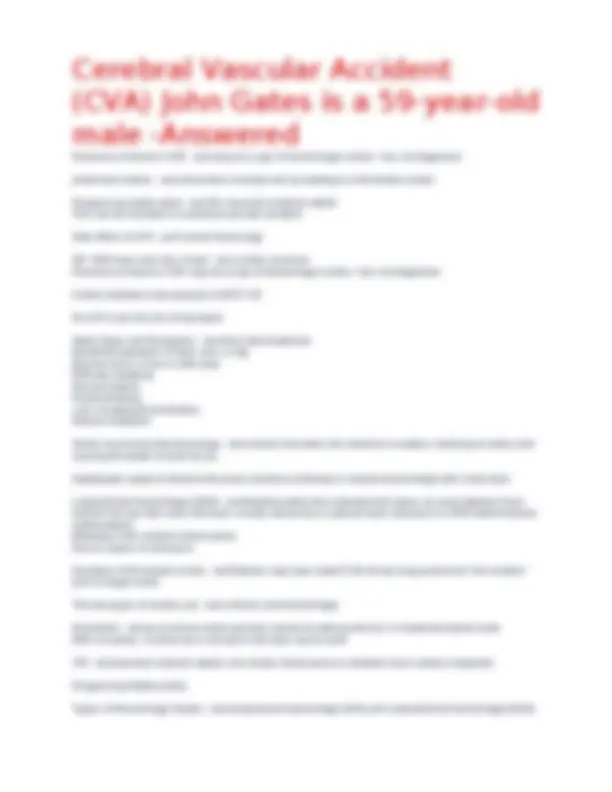
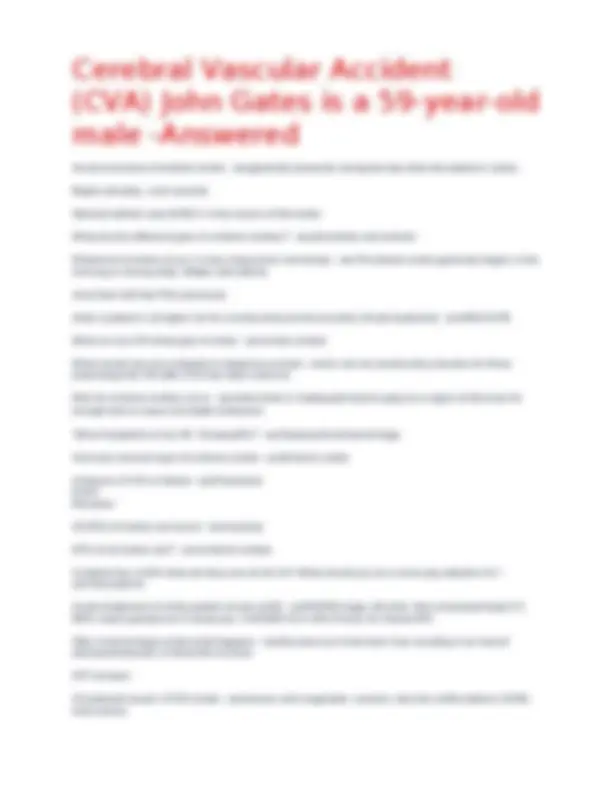
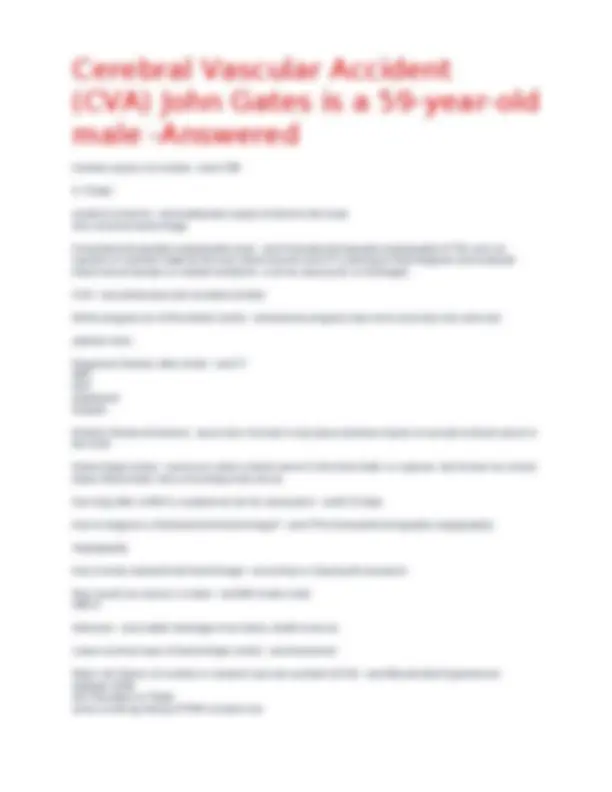
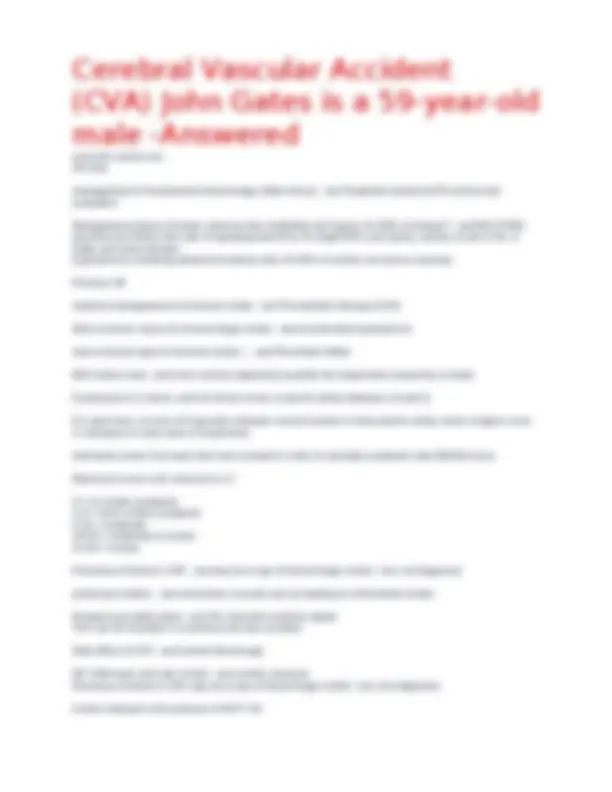
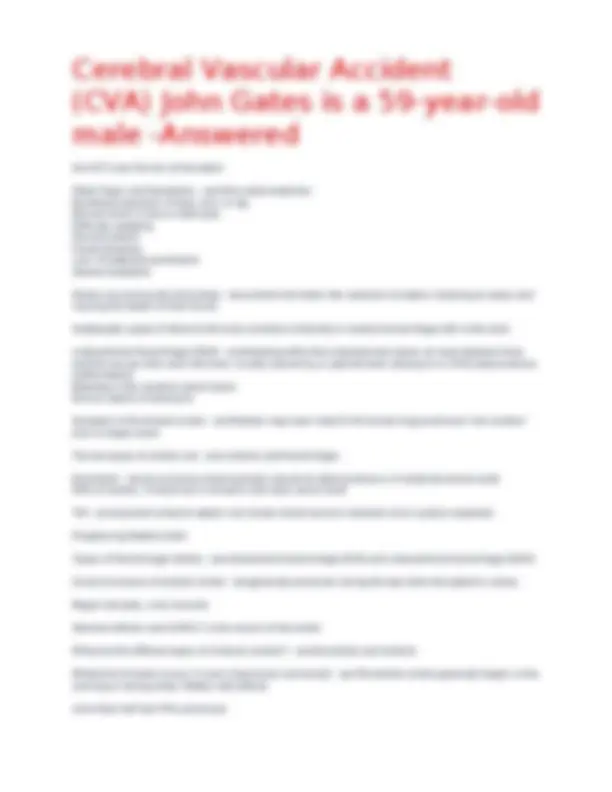
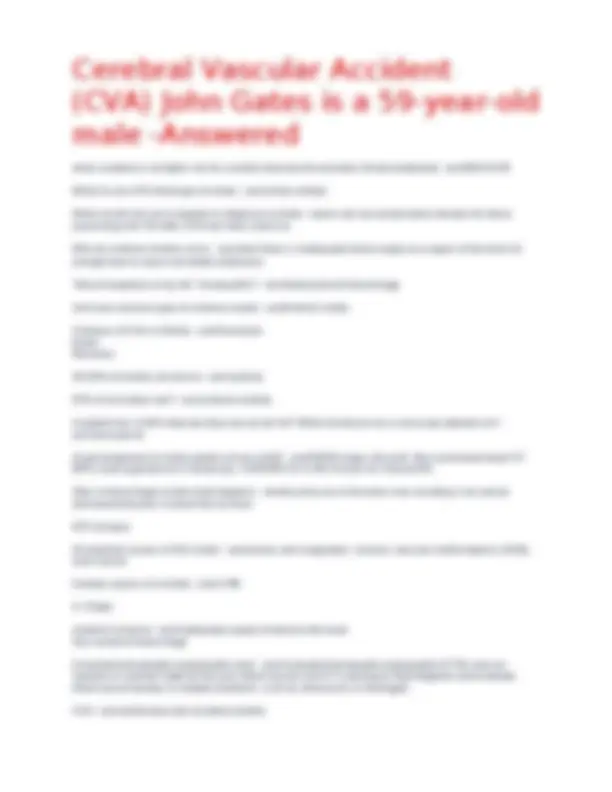
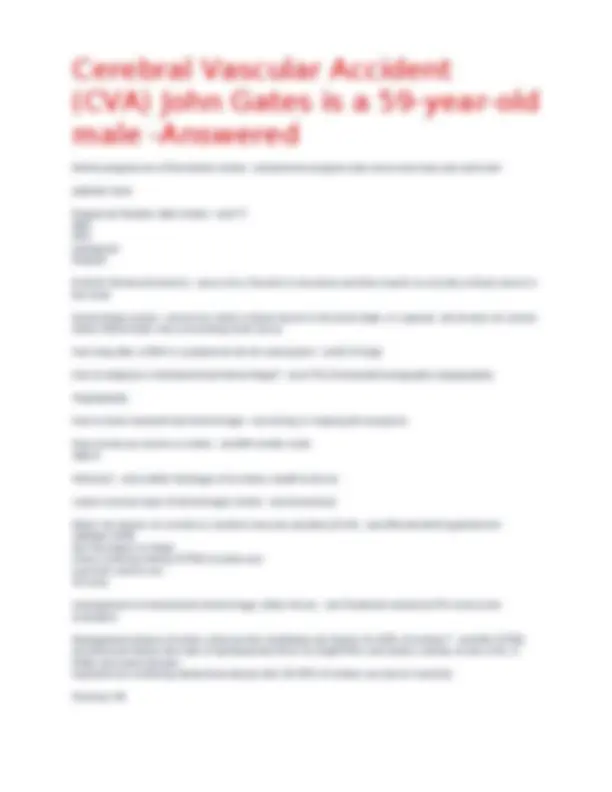
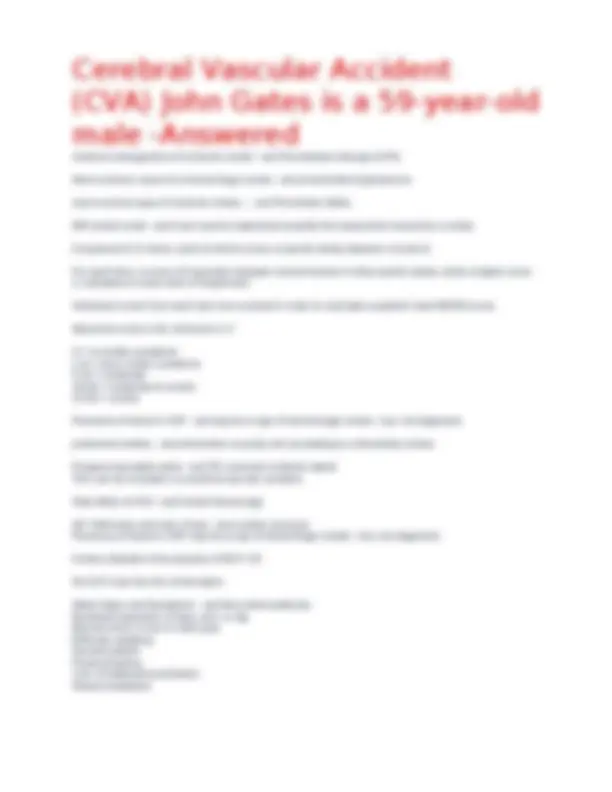
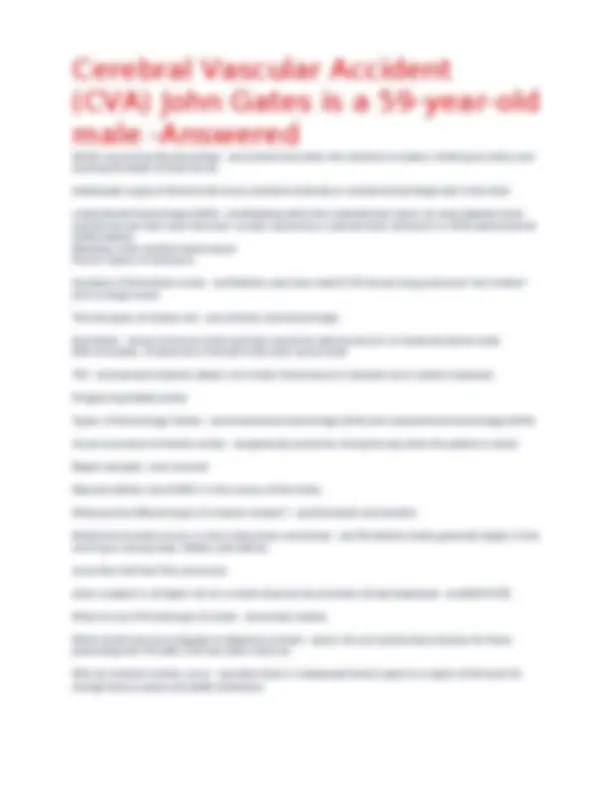
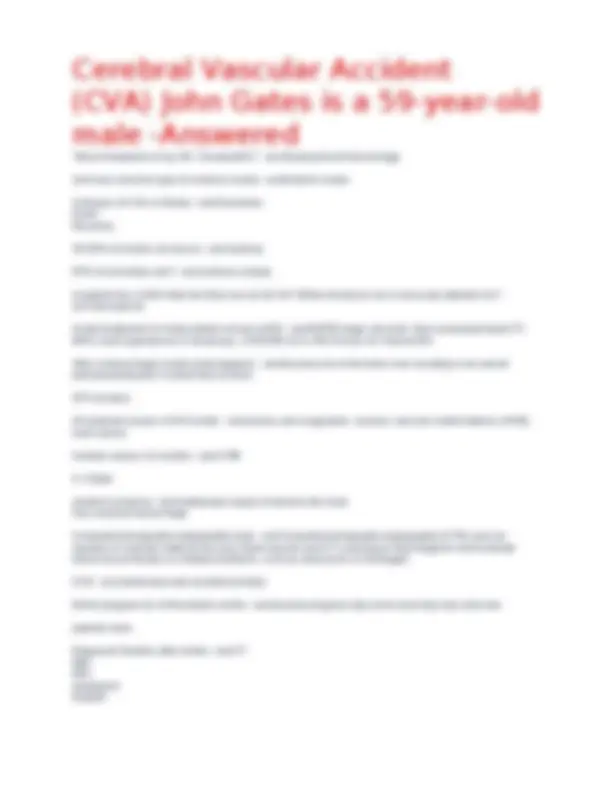
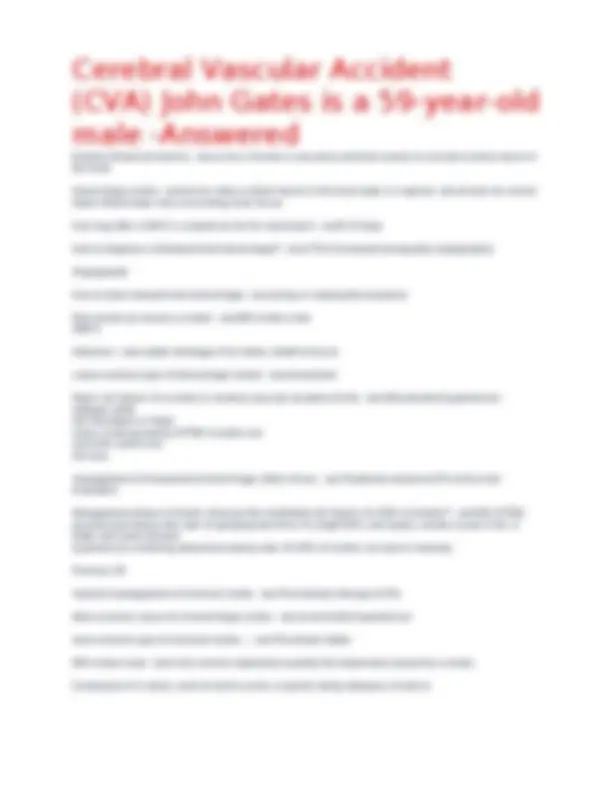
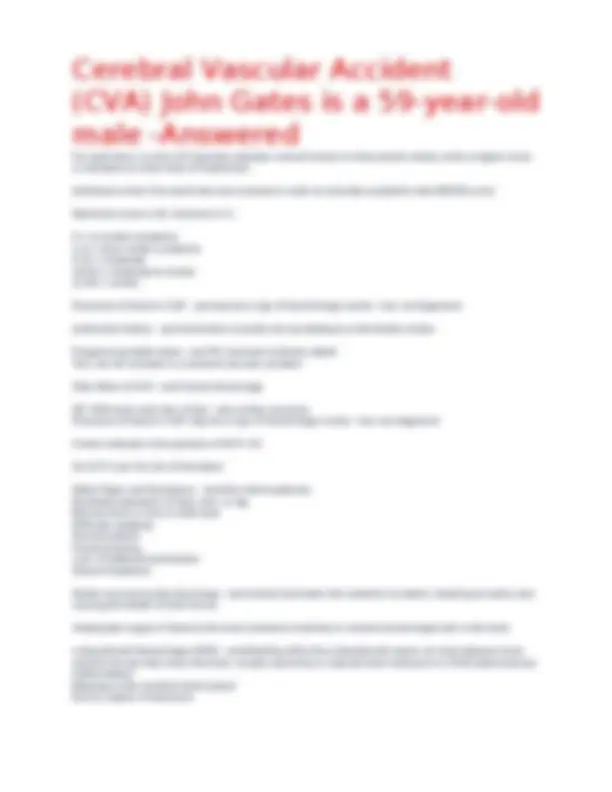
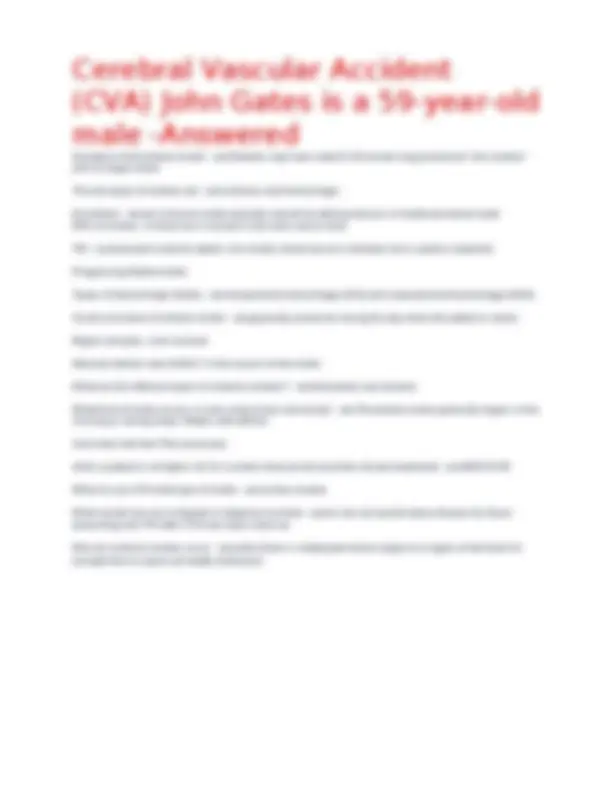
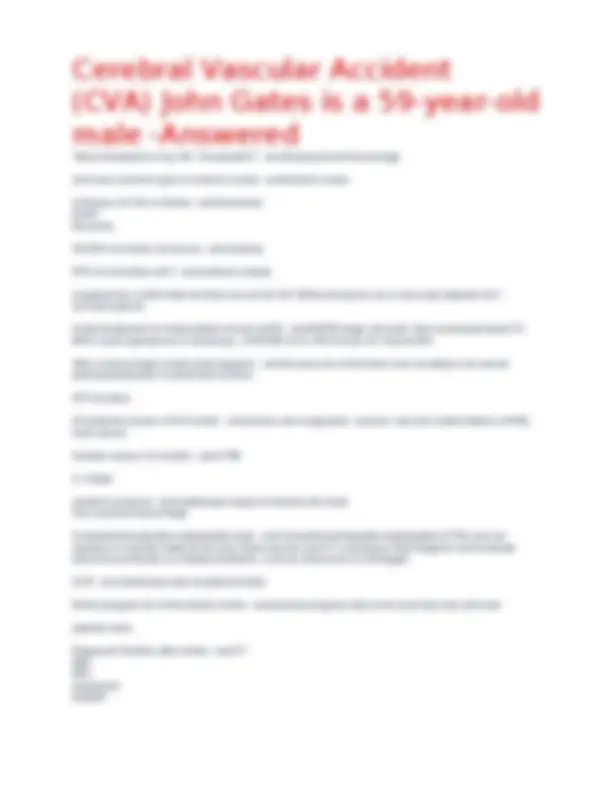
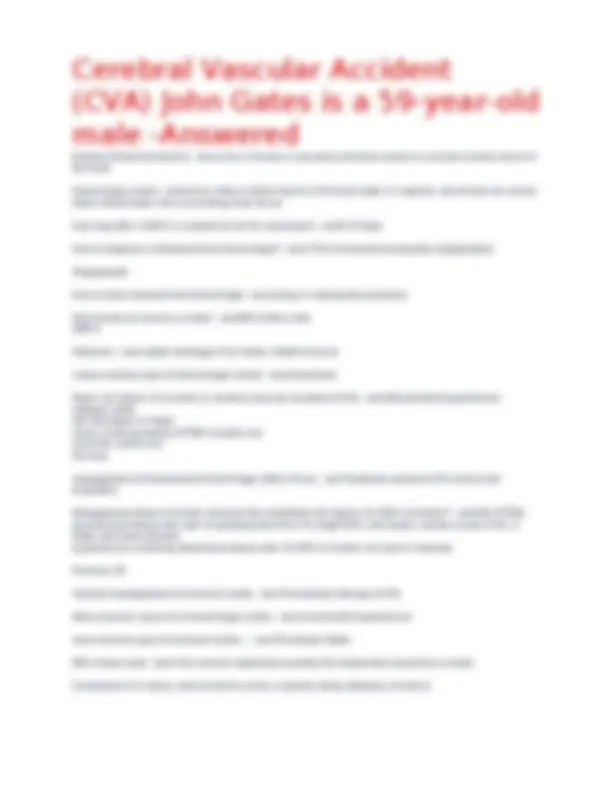
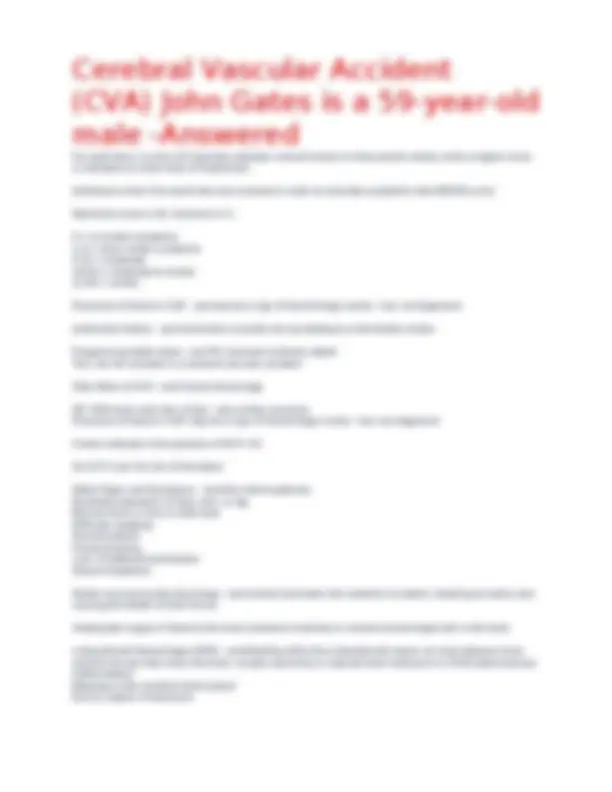
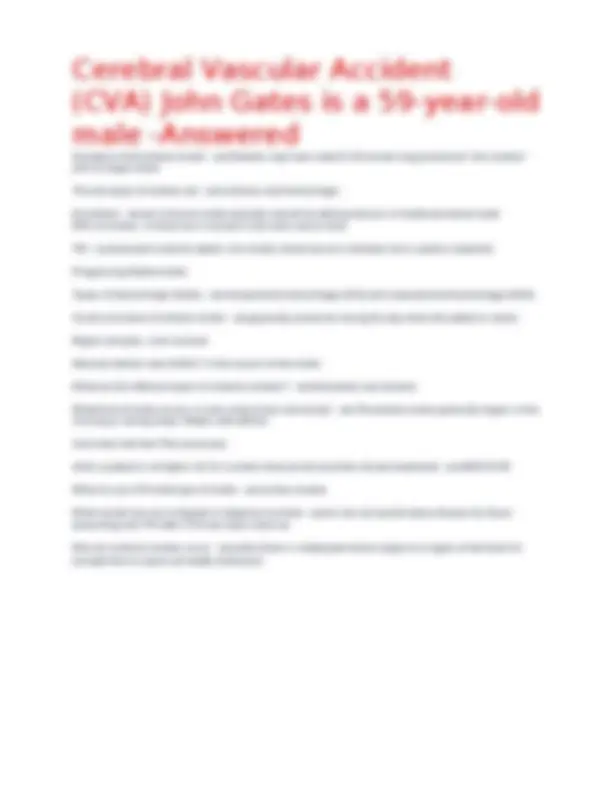


Study with the several resources on Docsity

Earn points by helping other students or get them with a premium plan


Prepare for your exams
Study with the several resources on Docsity

Earn points to download
Earn points by helping other students or get them with a premium plan
Community
Ask the community for help and clear up your study doubts
Discover the best universities in your country according to Docsity users
Free resources
Download our free guides on studying techniques, anxiety management strategies, and thesis advice from Docsity tutors
An overview of assessing and managing different types of strokes, including subarachnoid hemorrhage and ischemic stroke. It covers risk factors, symptoms, diagnostic tools, and treatment methods for each type of stroke. The document also discusses the importance of controlling major risk factors such as uncontrolled hypertension, diabetes, and smoking to prevent strokes.
Typology: Exams
1 / 38

This page cannot be seen from the preview
Don't miss anything!































"Worst headache of my life". Disease/Dx? - ansSubarachnoid hemorrhage 2nd most common type of ischemic stroke - ansEmbolic stroke 3 phases of CVA or Stroke - ansPrevention Event Recovery 20-25% of strokes are due to - ansinactivity 87% of all strokes are? - ansischemic strokes A patient has a SAH what are they now at risk for? What should you as a nurse pay attention to? - ansVasospasms Acute treatement of stroke patient arrives at ED - ansRAPID triage, lab work, Non-contrasted head CT, NPO, treat hypertension if necessary. 3 HOURS for Iv tPA 8 hours for Arterial tPA After a hemorrhagic stroke what happens - ansthe pressure in the brain rises resulting in an overall decrease/reduction in blood flow to brain. ICP increase All potential causes of ICH stroke - anstrauma, anti-coagulants, cocaine, vascular malformations (AVM), brain tumors Cardiac causes of a stroke - ansA FIB A- Flutter cerebral ischemia - ansInadequate supply of blood to the brain Also cerebral hemorrhage Computed tomography angiography (cta) - ansComputed tomography angiography (CTA) uses an injection of contrast material into your blood vessels and CT scanning to help diagnose and evaluate blood vessel disease or related conditions, such as aneurysms or blockages. CVA - anscerebrovascular accident (stroke) Deficit progression of thrombotic stroke - ansbecome progressively worse and may wax and wain patients have Diagnositc Studies after stroke - ansCT MRI PET angiogram Doppler
Embolic Stroke (Ischemic) - ansa clot is formed in one place and then travels to occlude a blood vessel in the brain hemorrhagic stroke - ansoccurs when a blood vessel in the brain leaks or ruptures; also known as a brain bleed. Blood leaks into surrounding brain tissue how long after a SAH is a patient at risk for vasospasm - ans6-10 days how to diagnose a Subarachnoid hemorrhage? - ansCTA (Computed tomography angiography) Angiography how to treat subarachnoid hemorrhage - anscoiling or clipping the anyeryms How would you assess a stroke - ansNIH stroke scale ABCS Infarction - anssudden blockage of an artery, death to tissue Lease common type of hemorrhagic stroke - ansintracerbral Major risk factors of a stroke or cerebral vascular accident (CVA) - ansUNcontrolled hypertension diabetes (DM) Atril fibrulation or flutter stress smoking obesity ETOH/ cocaine use oral birth control use AA race management of intracerebral hemorrhage. (Main focus) - ansTreatment aimed at ICP control and evaluation Management phase of stroke, what are the modifiable risk factors for 90% of strokes? - ansDM, ETOH, psychosocial factors,the ratio of apolipoprotein B to A1 (highCHOL and lipids), cardiac issues A-fib, A flutter and valve disease hypertension smokeing abdominal obesity diet, 20-25% of strokes are due to inactivity Previous MI medical mamagement of ischemic stroke - ansThrombolytic therapy (t-PA) Most common cause of a hemorrhagic stroke - ansuncontrolled hypertension most common type of ischemic stroke... - ansThrombotic Stoke NIH stroke scale - ansA tool used to objectively quantify the impairment caused by a stroke Composed of 11 items, each of which scores a specific ability between a 0 and 4.
Symptom of thrombotic stroke - ansPatients may have noted 5-30 minute long prodromal "mini strokes" prior to larger event The two types of strokes are - ansischemic and hemorrhagic thrombotic - ansan occlusive stroke typically caused by atherosclerosis or hardened arterial walls 65% of strokes. A blood clot is formed in the brain vessel itself TIA - anstransient ischemic attack; mini stroke; blood vessel is blocked, but is quickly reopened. Progressing Stable stroke Types of Hemorrhagic Stroke - ansintracerebral hemorrhage (ICH) and subarachnoid hemorrhage (SAH) Usual occurance of embolic stroke - ansgenerally presesnts during the day when the patient is active. Begins abruptly...over seconds Maximal deficits seen EARLY in the course of the stroke What are the different types of ischemic strokes? - ansthrombotic and embolic What kind of stroke occurs in ones sleep (most commonly) - ansThrombotic stroke generally begins in the morning or during sleep. Wakes with deficits. more than half had TIAs previously when a patient is at higher risk for a stroke what are the priorities (Acute treatment) - ansEDUCATE When to use t-PA what type of stroke - ansischeic strokes When would one use a doppler to diagnose a stroke - ansto rule out carotid artery disease for those presenting with TIA after CVA has been ruled out Why do ischemic strokes occur - answhen there is inadequate blood supply to a region of the brain for enough time to cause cell death (infarction) "Worst headache of my life". Disease/Dx? - ansSubarachnoid hemorrhage 2nd most common type of ischemic stroke - ansEmbolic stroke 3 phases of CVA or Stroke - ansPrevention Event Recovery 20-25% of strokes are due to - ansinactivity 87% of all strokes are? - ansischemic strokes
A patient has a SAH what are they now at risk for? What should you as a nurse pay attention to? - ansVasospasms Acute treatement of stroke patient arrives at ED - ansRAPID triage, lab work, Non-contrasted head CT, NPO, treat hypertension if necessary. 3 HOURS for Iv tPA 8 hours for Arterial tPA After a hemorrhagic stroke what happens - ansthe pressure in the brain rises resulting in an overall decrease/reduction in blood flow to brain. ICP increase All potential causes of ICH stroke - anstrauma, anti-coagulants, cocaine, vascular malformations (AVM), brain tumors Cardiac causes of a stroke - ansA FIB A- Flutter cerebral ischemia - ansInadequate supply of blood to the brain Also cerebral hemorrhage Computed tomography angiography (cta) - ansComputed tomography angiography (CTA) uses an injection of contrast material into your blood vessels and CT scanning to help diagnose and evaluate blood vessel disease or related conditions, such as aneurysms or blockages. CVA - anscerebrovascular accident (stroke) Deficit progression of thrombotic stroke - ansbecome progressively worse and may wax and wain patients have Diagnositc Studies after stroke - ansCT MRI PET angiogram Doppler Embolic Stroke (Ischemic) - ansa clot is formed in one place and then travels to occlude a blood vessel in the brain hemorrhagic stroke - ansoccurs when a blood vessel in the brain leaks or ruptures; also known as a brain bleed. Blood leaks into surrounding brain tissue how long after a SAH is a patient at risk for vasospasm - ans6-10 days how to diagnose a Subarachnoid hemorrhage? - ansCTA (Computed tomography angiography) Angiography
Presence of blood in CSF - ansmay be a sign of hemorrhagic stroke - but, not diagnostic prodromal strokes - ansministrokes ususally end up leading to a thrombotic stroke Progressing stable stoke - ansTIA, transient ischemic attack This can be included in a cerebral vascular accident Side effect of t-PA - ansCerbral Hemorrage SP. SAH tests and risks of test - ansLumber puncture Presence of blood in CSF may be a sign of hemorrhagic stroke - but, not diagnostic Contra indicaed in the precene of IICP > So CAT scan first b/c of herniation Stoke Signs and Symptoms - ansOne sided weakness Numbness/paralysis of face, arm, or leg Blurred vision in one or both eyes Difficulty speaking Slurred speech Facial drooping Loss of balance/coordination Severe headache Stroke occurrence the physiology - ansa blood clot enters the cerebral circulation, blocking an artery and causing the death of brain tissue. Inadequate supply of blood to the brain (cerebral ischemia) or cerebra hemorrhage with in the brain subarachnoid hemorrhage (SAH) - ansbleeding within the subarachnoid space, an area between brain and thin tissues that cover the brain; usually caused by a ruptured brain aneurysm or AVM (arteriovenous malformation) Bleeding in the cerebral spinal space Due to rupture of aneurysm Symptom of thrombotic stroke - ansPatients may have noted 5-30 minute long prodromal "mini strokes" prior to larger event The two types of strokes are - ansischemic and hemorrhagic thrombotic - ansan occlusive stroke typically caused by atherosclerosis or hardened arterial walls 65% of strokes. A blood clot is formed in the brain vessel itself TIA - anstransient ischemic attack; mini stroke; blood vessel is blocked, but is quickly reopened. Progressing Stable stroke Types of Hemorrhagic Stroke - ansintracerebral hemorrhage (ICH) and subarachnoid hemorrhage (SAH)
Usual occurance of embolic stroke - ansgenerally presesnts during the day when the patient is active. Begins abruptly...over seconds Maximal deficits seen EARLY in the course of the stroke What are the different types of ischemic strokes? - ansthrombotic and embolic What kind of stroke occurs in ones sleep (most commonly) - ansThrombotic stroke generally begins in the morning or during sleep. Wakes with deficits. more than half had TIAs previously when a patient is at higher risk for a stroke what are the priorities (Acute treatment) - ansEDUCATE When to use t-PA what type of stroke - ansischeic strokes When would one use a doppler to diagnose a stroke - ansto rule out carotid artery disease for those presenting with TIA after CVA has been ruled out Why do ischemic strokes occur - answhen there is inadequate blood supply to a region of the brain for enough time to cause cell death (infarction) "Worst headache of my life". Disease/Dx? - ansSubarachnoid hemorrhage 2nd most common type of ischemic stroke - ansEmbolic stroke 3 phases of CVA or Stroke - ansPrevention Event Recovery 20-25% of strokes are due to - ansinactivity 87% of all strokes are? - ansischemic strokes A patient has a SAH what are they now at risk for? What should you as a nurse pay attention to? - ansVasospasms Acute treatement of stroke patient arrives at ED - ansRAPID triage, lab work, Non-contrasted head CT, NPO, treat hypertension if necessary. 3 HOURS for Iv tPA 8 hours for Arterial tPA After a hemorrhagic stroke what happens - ansthe pressure in the brain rises resulting in an overall decrease/reduction in blood flow to brain. ICP increase All potential causes of ICH stroke - anstrauma, anti-coagulants, cocaine, vascular malformations (AVM), brain tumors
oral birth control use AA race management of intracerebral hemorrhage. (Main focus) - ansTreatment aimed at ICP control and evaluation Management phase of stroke, what are the modifiable risk factors for 90% of strokes? - ansDM, ETOH, psychosocial factors,the ratio of apolipoprotein B to A1 (highCHOL and lipids), cardiac issues A-fib, A flutter and valve disease hypertension smokeing abdominal obesity diet, 20-25% of strokes are due to inactivity Previous MI medical mamagement of ischemic stroke - ansThrombolytic therapy (t-PA) Most common cause of a hemorrhagic stroke - ansuncontrolled hypertension most common type of ischemic stroke... - ansThrombotic Stoke NIH stroke scale - ansA tool used to objectively quantify the impairment caused by a stroke Composed of 11 items, each of which scores a specific ability between a 0 and 4. For each item, a score of 0 typically indicates normal function in that specific ability, while a higher score is indicative of some level of impairment Individual scores from each item are summed in order to calculate a patient's total NIHSS score. Maximum score is 42, minimum is 0 : 0 = no stroke symptoms 1-4 = minor stroke symptoms 5-15 = moderate 16-20 = moderate to severe 21-42 = severe Presence of blood in CSF - ansmay be a sign of hemorrhagic stroke - but, not diagnostic prodromal strokes - ansministrokes ususally end up leading to a thrombotic stroke Progressing stable stoke - ansTIA, transient ischemic attack This can be included in a cerebral vascular accident Side effect of t-PA - ansCerbral Hemorrage SP. SAH tests and risks of test - ansLumber puncture Presence of blood in CSF may be a sign of hemorrhagic stroke - but, not diagnostic Contra indicaed in the precene of IICP >
So CAT scan first b/c of herniation Stoke Signs and Symptoms - ansOne sided weakness Numbness/paralysis of face, arm, or leg Blurred vision in one or both eyes Difficulty speaking Slurred speech Facial drooping Loss of balance/coordination Severe headache Stroke occurrence the physiology - ansa blood clot enters the cerebral circulation, blocking an artery and causing the death of brain tissue. Inadequate supply of blood to the brain (cerebral ischemia) or cerebra hemorrhage with in the brain subarachnoid hemorrhage (SAH) - ansbleeding within the subarachnoid space, an area between brain and thin tissues that cover the brain; usually caused by a ruptured brain aneurysm or AVM (arteriovenous malformation) Bleeding in the cerebral spinal space Due to rupture of aneurysm Symptom of thrombotic stroke - ansPatients may have noted 5-30 minute long prodromal "mini strokes" prior to larger event The two types of strokes are - ansischemic and hemorrhagic thrombotic - ansan occlusive stroke typically caused by atherosclerosis or hardened arterial walls 65% of strokes. A blood clot is formed in the brain vessel itself TIA - anstransient ischemic attack; mini stroke; blood vessel is blocked, but is quickly reopened. Progressing Stable stroke Types of Hemorrhagic Stroke - ansintracerebral hemorrhage (ICH) and subarachnoid hemorrhage (SAH) Usual occurance of embolic stroke - ansgenerally presesnts during the day when the patient is active. Begins abruptly...over seconds Maximal deficits seen EARLY in the course of the stroke What are the different types of ischemic strokes? - ansthrombotic and embolic What kind of stroke occurs in ones sleep (most commonly) - ansThrombotic stroke generally begins in the morning or during sleep. Wakes with deficits. more than half had TIAs previously
Deficit progression of thrombotic stroke - ansbecome progressively worse and may wax and wain patients have Diagnositc Studies after stroke - ansCT MRI PET angiogram Doppler Embolic Stroke (Ischemic) - ansa clot is formed in one place and then travels to occlude a blood vessel in the brain hemorrhagic stroke - ansoccurs when a blood vessel in the brain leaks or ruptures; also known as a brain bleed. Blood leaks into surrounding brain tissue how long after a SAH is a patient at risk for vasospasm - ans6-10 days how to diagnose a Subarachnoid hemorrhage? - ansCTA (Computed tomography angiography) Angiography how to treat subarachnoid hemorrhage - anscoiling or clipping the anyeryms How would you assess a stroke - ansNIH stroke scale ABCS Infarction - anssudden blockage of an artery, death to tissue Lease common type of hemorrhagic stroke - ansintracerbral Major risk factors of a stroke or cerebral vascular accident (CVA) - ansUNcontrolled hypertension diabetes (DM) Atril fibrulation or flutter stress smoking obesity ETOH/ cocaine use oral birth control use AA race management of intracerebral hemorrhage. (Main focus) - ansTreatment aimed at ICP control and evaluation Management phase of stroke, what are the modifiable risk factors for 90% of strokes? - ansDM, ETOH, psychosocial factors,the ratio of apolipoprotein B to A1 (highCHOL and lipids), cardiac issues A-fib, A flutter and valve disease hypertension smokeing abdominal obesity diet, 20-25% of strokes are due to inactivity Previous MI
medical mamagement of ischemic stroke - ansThrombolytic therapy (t-PA) Most common cause of a hemorrhagic stroke - ansuncontrolled hypertension most common type of ischemic stroke... - ansThrombotic Stoke NIH stroke scale - ansA tool used to objectively quantify the impairment caused by a stroke Composed of 11 items, each of which scores a specific ability between a 0 and 4. For each item, a score of 0 typically indicates normal function in that specific ability, while a higher score is indicative of some level of impairment Individual scores from each item are summed in order to calculate a patient's total NIHSS score. Maximum score is 42, minimum is 0 : 0 = no stroke symptoms 1-4 = minor stroke symptoms 5-15 = moderate 16-20 = moderate to severe 21-42 = severe Presence of blood in CSF - ansmay be a sign of hemorrhagic stroke - but, not diagnostic prodromal strokes - ansministrokes ususally end up leading to a thrombotic stroke Progressing stable stoke - ansTIA, transient ischemic attack This can be included in a cerebral vascular accident Side effect of t-PA - ansCerbral Hemorrage SP. SAH tests and risks of test - ansLumber puncture Presence of blood in CSF may be a sign of hemorrhagic stroke - but, not diagnostic Contra indicaed in the precene of IICP > So CAT scan first b/c of herniation Stoke Signs and Symptoms - ansOne sided weakness Numbness/paralysis of face, arm, or leg Blurred vision in one or both eyes Difficulty speaking Slurred speech Facial drooping Loss of balance/coordination Severe headache
2nd most common type of ischemic stroke - ansEmbolic stroke 3 phases of CVA or Stroke - ansPrevention Event Recovery 20-25% of strokes are due to - ansinactivity 87% of all strokes are? - ansischemic strokes A patient has a SAH what are they now at risk for? What should you as a nurse pay attention to? - ansVasospasms Acute treatement of stroke patient arrives at ED - ansRAPID triage, lab work, Non-contrasted head CT, NPO, treat hypertension if necessary. 3 HOURS for Iv tPA 8 hours for Arterial tPA After a hemorrhagic stroke what happens - ansthe pressure in the brain rises resulting in an overall decrease/reduction in blood flow to brain. ICP increase All potential causes of ICH stroke - anstrauma, anti-coagulants, cocaine, vascular malformations (AVM), brain tumors Cardiac causes of a stroke - ansA FIB A- Flutter cerebral ischemia - ansInadequate supply of blood to the brain Also cerebral hemorrhage Computed tomography angiography (cta) - ansComputed tomography angiography (CTA) uses an injection of contrast material into your blood vessels and CT scanning to help diagnose and evaluate blood vessel disease or related conditions, such as aneurysms or blockages. CVA - anscerebrovascular accident (stroke) Deficit progression of thrombotic stroke - ansbecome progressively worse and may wax and wain patients have Diagnositc Studies after stroke - ansCT MRI PET angiogram Doppler
Embolic Stroke (Ischemic) - ansa clot is formed in one place and then travels to occlude a blood vessel in the brain hemorrhagic stroke - ansoccurs when a blood vessel in the brain leaks or ruptures; also known as a brain bleed. Blood leaks into surrounding brain tissue how long after a SAH is a patient at risk for vasospasm - ans6-10 days how to diagnose a Subarachnoid hemorrhage? - ansCTA (Computed tomography angiography) Angiography how to treat subarachnoid hemorrhage - anscoiling or clipping the anyeryms How would you assess a stroke - ansNIH stroke scale ABCS Infarction - anssudden blockage of an artery, death to tissue Lease common type of hemorrhagic stroke - ansintracerbral Major risk factors of a stroke or cerebral vascular accident (CVA) - ansUNcontrolled hypertension diabetes (DM) Atril fibrulation or flutter stress smoking obesity ETOH/ cocaine use oral birth control use AA race management of intracerebral hemorrhage. (Main focus) - ansTreatment aimed at ICP control and evaluation Management phase of stroke, what are the modifiable risk factors for 90% of strokes? - ansDM, ETOH, psychosocial factors,the ratio of apolipoprotein B to A1 (highCHOL and lipids), cardiac issues A-fib, A flutter and valve disease hypertension smokeing abdominal obesity diet, 20-25% of strokes are due to inactivity Previous MI medical mamagement of ischemic stroke - ansThrombolytic therapy (t-PA) Most common cause of a hemorrhagic stroke - ansuncontrolled hypertension most common type of ischemic stroke... - ansThrombotic Stoke NIH stroke scale - ansA tool used to objectively quantify the impairment caused by a stroke Composed of 11 items, each of which scores a specific ability between a 0 and 4.
Symptom of thrombotic stroke - ansPatients may have noted 5-30 minute long prodromal "mini strokes" prior to larger event The two types of strokes are - ansischemic and hemorrhagic thrombotic - ansan occlusive stroke typically caused by atherosclerosis or hardened arterial walls 65% of strokes. A blood clot is formed in the brain vessel itself TIA - anstransient ischemic attack; mini stroke; blood vessel is blocked, but is quickly reopened. Progressing Stable stroke Types of Hemorrhagic Stroke - ansintracerebral hemorrhage (ICH) and subarachnoid hemorrhage (SAH) Usual occurance of embolic stroke - ansgenerally presesnts during the day when the patient is active. Begins abruptly...over seconds Maximal deficits seen EARLY in the course of the stroke What are the different types of ischemic strokes? - ansthrombotic and embolic What kind of stroke occurs in ones sleep (most commonly) - ansThrombotic stroke generally begins in the morning or during sleep. Wakes with deficits. more than half had TIAs previously when a patient is at higher risk for a stroke what are the priorities (Acute treatment) - ansEDUCATE When to use t-PA what type of stroke - ansischeic strokes When would one use a doppler to diagnose a stroke - ansto rule out carotid artery disease for those presenting with TIA after CVA has been ruled out Why do ischemic strokes occur - answhen there is inadequate blood supply to a region of the brain for enough time to cause cell death (infarction) "Worst headache of my life". Disease/Dx? - ansSubarachnoid hemorrhage 2nd most common type of ischemic stroke - ansEmbolic stroke 3 phases of CVA or Stroke - ansPrevention Event Recovery 20-25% of strokes are due to - ansinactivity 87% of all strokes are? - ansischemic strokes
A patient has a SAH what are they now at risk for? What should you as a nurse pay attention to? - ansVasospasms Acute treatement of stroke patient arrives at ED - ansRAPID triage, lab work, Non-contrasted head CT, NPO, treat hypertension if necessary. 3 HOURS for Iv tPA 8 hours for Arterial tPA After a hemorrhagic stroke what happens - ansthe pressure in the brain rises resulting in an overall decrease/reduction in blood flow to brain. ICP increase All potential causes of ICH stroke - anstrauma, anti-coagulants, cocaine, vascular malformations (AVM), brain tumors Cardiac causes of a stroke - ansA FIB A- Flutter cerebral ischemia - ansInadequate supply of blood to the brain Also cerebral hemorrhage Computed tomography angiography (cta) - ansComputed tomography angiography (CTA) uses an injection of contrast material into your blood vessels and CT scanning to help diagnose and evaluate blood vessel disease or related conditions, such as aneurysms or blockages. CVA - anscerebrovascular accident (stroke) Deficit progression of thrombotic stroke - ansbecome progressively worse and may wax and wain patients have Diagnositc Studies after stroke - ansCT MRI PET angiogram Doppler Embolic Stroke (Ischemic) - ansa clot is formed in one place and then travels to occlude a blood vessel in the brain hemorrhagic stroke - ansoccurs when a blood vessel in the brain leaks or ruptures; also known as a brain bleed. Blood leaks into surrounding brain tissue how long after a SAH is a patient at risk for vasospasm - ans6-10 days how to diagnose a Subarachnoid hemorrhage? - ansCTA (Computed tomography angiography) Angiography